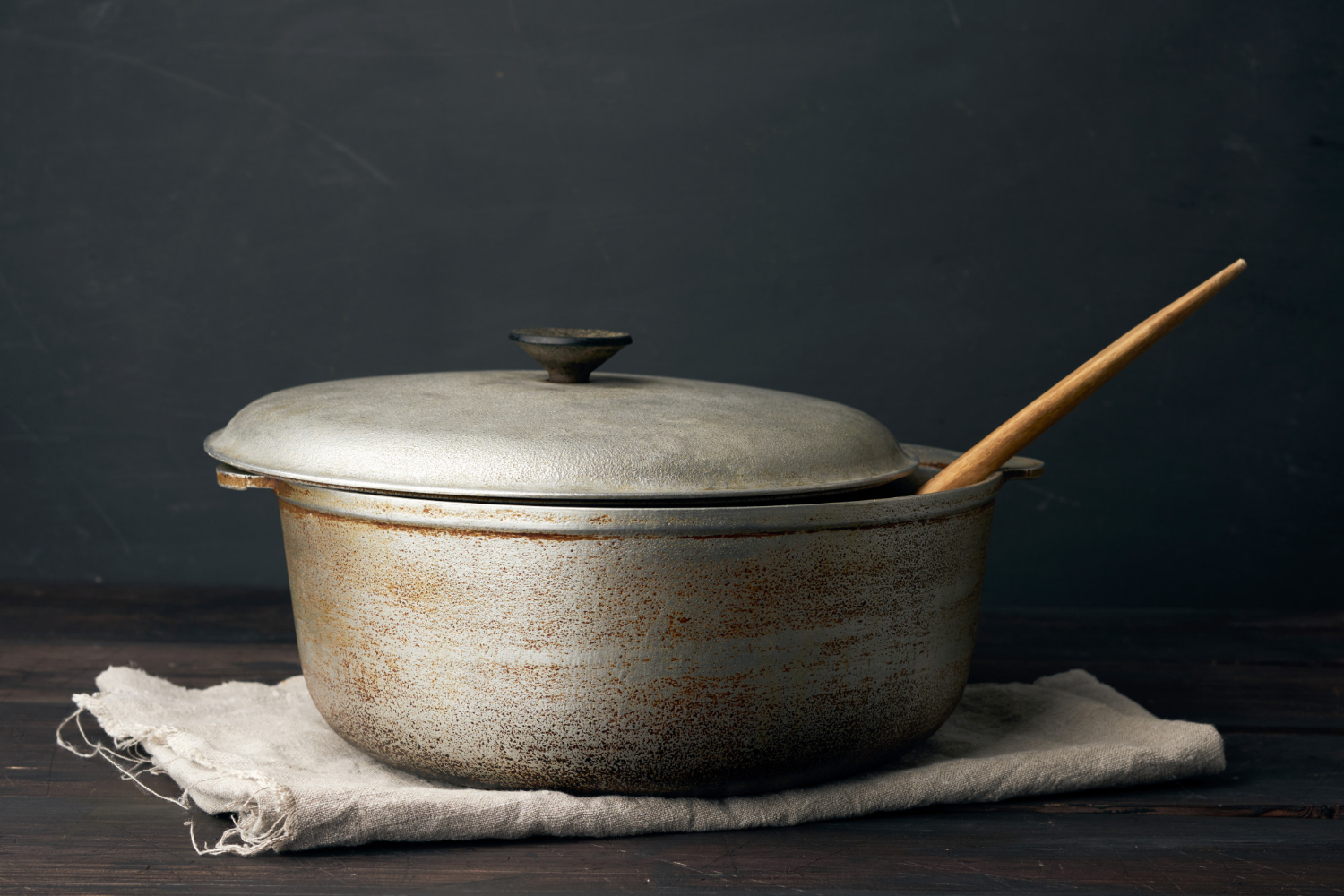Aluminum pans are popular because they are cheap and distribute heat evenly. However, oxidation causes dark gray or black marks on aluminum pans. These marks are caused by aluminum oxidation. Specific measures can help reduce oxidation, but it will still occur on non-anodized aluminum pans.
Pots, pans, utensils, and even sinks used regularly can become dull. This is a non-toxic tarnish that forms when metal reacts with oxygen in the environment. Do not be concerned; simple DIY cleaning products and store-bought cleaning products will bring back the luster.
Is Discolored Aluminum Cookware Safe?
When aluminum has contact with air, it oxidizes (turns brown). As a result, the residue on your hands may be black or gray. That oxidation will most especially present on the pan if the pan has been sitting for an extended period. Foods that are acidic or that have been washed in the dishwasher can also cause oxidation.
Putting your aluminum in the dishwasher is one of the things that will promote oxidation. Dishwashers can cause aluminum objects to rub against each other, accelerating the oxidation process and resulting in black and gray marks. Prevent this by hand washing the aluminum or placing the aluminum items in the dishwasher far apart.
While untreated aluminum is not dangerous, it should not be used with acidic foods because it will corrode both the food and the cookware. Also, anodized aluminum cookware or cookware clad in a non-reactive material, such as stainless steel or a nonstick coating, does not leach into or react with foods.
What Makes Aluminum Pans Turn Dark?
Aluminum pans are widely used because aluminum is a low-cost metal that is light and conducts heat evenly. However, you may notice that the aluminum pan is acquiring black or dark gray marks. These marks are a natural byproduct of the oxidation of aluminum.
Your pots may turn black if the heat is turned up too high or your gas stove is not heating evenly. Also, if the heat is uneven, the flame will appear blue on the outside and yellow on the inside. Until the flame is blue, adjust your air intake valve.
Aluminum cookware can react and darken when washed in a dishwasher due to mineral content in the water, chemicals in the detergent, or high heat from the dryer. However, natural products such as lemon juice, vinegar, or cream of tartar remove discoloration quickly and effectively without harming the metal.
This process gives eggs their black color because the vessel’s top layer oxidizes during the heating process, leading to the development of black on the surface. Also, cooking food in aluminum pots increases the amount of aluminum absorbed into the food, leading to illness.
Before cooking, mix five cups of water and five tablespoons of white vinegar in the pan. While the vinegar solution in a pan is heating, the water will gradually darken to a deep, rich color. Once the black residue has been removed, pour the solution down the drain and repeat the procedure until the vinegar-water solution is clear. To remove black stains, use a scrubbing pad soaked in white vinegar to clean the outside of the pan.
Deglazing the pans immediately after cooking keeps them from turning black. Deglazing your cooking pans can be accomplished in the following ways: Remove your empty cooking pot from the stove after you’ve finished cooking. Then, while the cookware is still hot, add a cup of cold water.
How Do You Clean Aluminum That Has Turned Black?
Aluminum. It’s probably in your pots, pans, and utensils. Your outdoor furniture or sink could also be made of aluminum. Unfortunately, it, like all metals, becomes dingy with time and use. With our tips on cleaning aluminum, you can restore the luster to your pots and pans.
While built-up grease and grime, as well as burnt-on food, can wreak havoc on any pan, aluminum pans face an additional foe: dishwashers.
Aluminum pans, like cast-iron cookware, should be avoided at all costs. The reaction between alkaline dishwasher detergent, high heat, and minerals in your water can cause the metal to darken. Not to mention that the force of the jets can cause your pan to collide with another dishware, scratching or nicking the surface.
How to clean
- Scrub the pan using a coarse-finish sponge or scrubber, using warm water and mild dish soap. Avoid using a metal utensil on it, as this can also damage the surface. But don’t worry if you’ve already run your pan through the dishwasher cycle—the darkening isn’t usually permanent.
- Many commercial cleaners can be used to clean aluminum. Still, you can also make natural cleaners that are inexpensive, environmentally friendly, and effective using ingredients in your kitchen.
- Clean the inside of an aluminum pot by filling it halfway with water. To each quart of water, add two tablespoons of cream of tartar and half a cup of vinegar. Allow the water to boil for 10 minutes, and then remove it from the heat. Next, drain the cleaner, let the cookware cool to the touch, and remove it from the heat. Wash as usual using soap and hot water.
- Clean stubborn stains by using a steel wool pad. Lemon juice is an exceptional substitute for vinegar. Place any discolored aluminum utensils in boiling water for 10 minutes to remove the discoloration. Now that the water has been removed from the pot, they will be as clean as possible.
- To clean aluminum, add apple peels to a pot of water and boil them for a few minutes. Next, pour enough liquid into a pot to cover the peels and bring to a boil. Slowly simmer, keeping the heat low, for 20 to 30 minutes. The acid in the apple is also responsible for giving your kitchen a pleasant scent.

